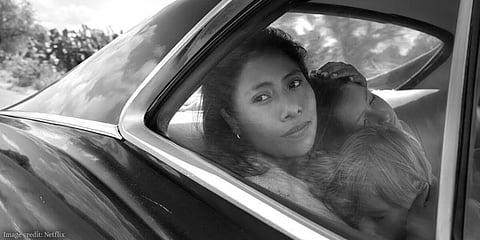
- Reviews
- Power List 2024
- Cannes 2024
- In-Depth Stories
- Web Stories
- News
- FC Lists
- Interviews
- Features
- FC SpecialsFC Specials

The popular aphorism is that power flows from the barrel of the gun. History has been witness to guns being used to propel as well as quell violence. Guns have been used to catalyse not only muscle power but also political power. But, an act of eschewing violence but being scathing nonetheless, is facilitated by the camera. Power also flows from the lens of a camera. Cinema is the most powerful tool to comfort the afflicted and afflict the comfortable. In Mexican director Alfonso Cuaron's 2018 monochrome memory piece Roma, Mexico City of the 70s breathes and basks under the assiduous oeuvre of the camera.
The opening shot of Roma is a static meditation on soap water getting splashed around on a floor. While the relevance of this shot is later weaved into the narrative, the cinematography establishes a mode of gaze fixation for the audience. The film offers us vignettes of a fictional recreation of Cuaron's childhood in the eponymous neighbourhood of Roma, Mexico City. This, alone, is sufficient to appreciate how personal the project is to the creator. He stages deeply moving and unnerving set pieces throughout the film as the narrative unfolds from the perspective of Cleo, who is employed as a nanny to the children of the family central to the story. Cleo, played with a stupefying disposition by an indigenous Mexican non-actor Yalitza Aparicio, is the pivot and Cuaron keeps her at the receiving end of various heart-rending ordeals. Cuaron deploys extreme wide-angle shots, pans, tracks across the city landscape as the characters move in and out of the frame like pedestrians in a busy thoroughfare. Fastidious mise-en-scene complements the slow and contemplative pace of the film, while the black-and-white aesthetic from the 65 mm camera lends seamlessly vivid images to the film. It is interesting to note Cuaron's aesthetic choice of capturing the Roma neighbourhood in monochrome despite it being home to vibrant and colourful facades.
Given that Cuaron has admittedly taken recourse to his memory lane to craft this project, he has burdened himself with certain responsibilities of representation. The uproarious response Roma has generated among casual movie watchers and cineastes alike, has raised a question regarding whether Roma has transcended the boundary of criticism and become sacrosanct. Cuaron uses Cleo's character as a knife just sharpened with a whetstone. She is a working-class, introverted woman who falls victim to sexual promiscuity. A pregnant Cleo is deserted by her lover who belongs to the same economic background as Cleo. Here Cuaron deliberately depicts a working-class man as an antagonist in order to provide leverage to the sympathy and care extended to Cleo by his upper-class mother and grandmother. In addition to this, he tries to portray the relationship between Cleo and her employers as one of love and mutual compassion. Thus, the question of representation of class division comes into picture. Whether Cuaron's mother's attitude toward Cleo was that of genuine affection or just liberal empathy, we will never know. But, we can safely infer from our own lived experiences that working-class people, people devoid of 'class consciousness', like domestic helps, have historically borne the brunt of class antagonism. It is a futile debate whether Cuaron trivialises the issue of class because the film is not so much interested in relationships as it is on one individual and her trials and tribulations.
There is also a feminist narrative which seems half-baked, running parallel to the storyline. Cuaron shows Cleo and Sofia (actually his mother) bonding over the common desertion of the men in their lives. Sofia tells Cleo things like 'women will always be alone' and thus Cuaron makes way for template message-packaging. Cleo, in one of her very few agentive actions, goes the extra mile to seek answers from her former lover, only to be greeted by his disavowal. Roma features the Corpus Christi Massacre of 1971, shows the government-paramilitary nexus and marries personal anecdotes with the contemporary socio-political landscape of Mexico, though nothing significant props out of this marriage other than the fact that Cleo's estranged lover was one of the student demonstrators. The film pits Cleo against the world and is, at one level, her story of surviving against odds. Therefore, Cuaron's memory actually serves as nothing but a vehicle for his nanny's experiences. Interestingly enough, the storytelling ingredients of Roma can be succinctly but effectively summed up using the title of Cuaron's debut feature : Love in the Time of Hysteria. The film has so much on its plate that it is hard to be absolutely objective about it. However, I cannot but think about the effectiveness of the end-product if we were to take away the self-conscious visual grandeur on display.
The same person donning the troika of writer, director and cinematographer means complete authorial control over a film. This control shows in every instant and the film can very well be his magnum opus, but Roma is actually a glorious revelation of Cuaron, the cinematographer. Unarguably the finest aspect of the film, the cinematography of Roma is breath-taking and lyrical. It will be criminal negligence to not mention the beach scene, which is filmed in a single shot, placed toward the fag end of the film. The magnificence of this scene is inexplicable yet mind-numbing ; my obeisance to Cuaron for pulling it off. Roma is an evocative craft with efficient set pieces, revolving around a doting nanny and exploiting the narcotic effect photographic images can have on the beholder.